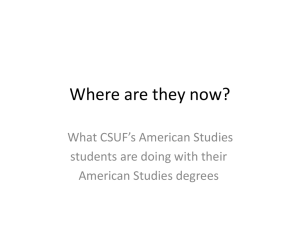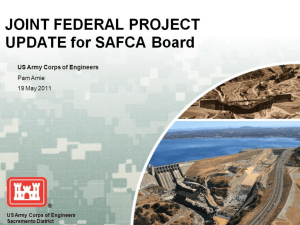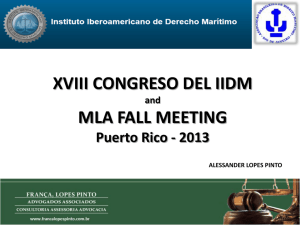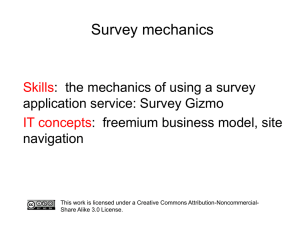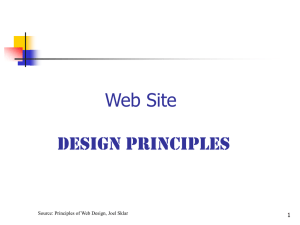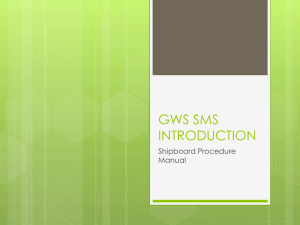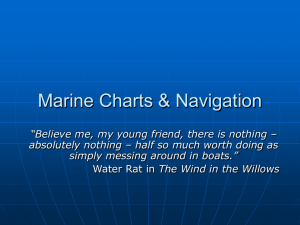Thoughts on Transportation BCA
advertisement
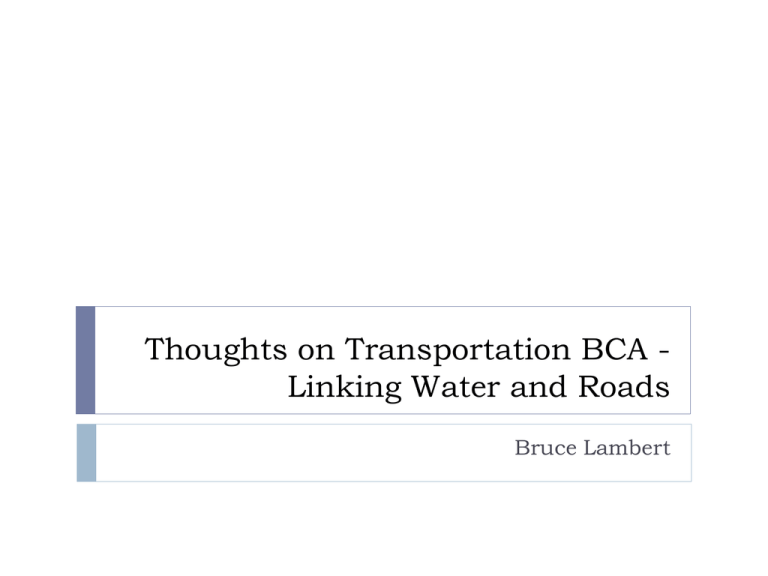
Thoughts on Transportation BCA Linking Water and Roads Bruce Lambert Good morning… Why examine linkages across modes? More State DOT’s have a navigation role All states have other waterway resource considerations General concerns over future of transportation activities and infrastructure demands Will a national dialogue on all public investment in infrastructure emerge? How Can One Look At Freight? Inventory Functions – physical characteristics, numbers of facilities, labor, equipment Engineering – structural integrity, deterioration Operational Reliability – delay, closures Economical and Financial – Cost/Benefit Analysis, capital and financial resources Traffic volumes and flows Safety and Security Sharing resources with non-freight users and goals Does Modes/Markets Matter? (Southeastern Average, 2007 tonnage) 100% 80% Other Pipeline Multiple modes & mail Air (include truck-air) Water Rail Truck 60% 40% 20% 0% Within From To Share of State Exports through a Port, 2011 100% 90% 80% 70% 60% 50% 40% 30% 20% 10% 0% Share of State GDP Exported through a Port, 2011 25% 20% 15% 10% 5% 0% “Hinterlands Matter” How is Navigation a Part of Freight System? Balance with existing international/ coastal flows Emissions and Environmental accountability Determine ways to encourage private sector investment in equipment, services Recognize regulatory obstacles Federal and State Multiagency planning, data, analysis Maritime Needs U.S. Public Port Projected Capital Expenditures by Expenditure Category for 2007-2011 (AAPA and Marad) Security 3% Dredging 10% Off-Terminal 3% General Cargo 14% On-Terminal 7% Specialized General Cargo 30% Other 23% Passanger 6% Dry Bulk Luquid Bulk 1% 3% Projected National Truck Flow Changes with Collapse of Bridge at Webbers Falls. s We all recognize… Need better data and analytical tools Need more guidance/support on non-traditional analysis Need to help others see the big picture Summary Need to consider Maritime System as part of a national system Maritime assets support commerce and exports What Does the Corps Do? Federal Role in U.S. Waterway Transport 1824 – authority to clear snags and make improvements Canal building era to mid-1800s (states) Post Civil War – suction dredging, jetties 1885: 1st of 46 locks and dams on Ohio 1930s: Present system of locks constructed on Upper Miss, Illinois, Tennessee, other waterways 1950s: Construction starts on present-day higher lift locks on Ohio 1960s-70s: Navigation improvements to Columbia-Snake, Arkansas River 1985: Tenn-Tom Waterway completed 1994 – Present: Upper Mississippi River & Illinois Waterway Navigation Study National Development Context 1824 – 1936: Nation Building Era of primarily Single Purpose Navigation Projects 1936 – 1986: Era of Economic Efficiency focusing on Multi-Purpose Projects 1969 – 1986: Era of Environmental Enlightenment, focusing on Multi-Objective Planning 1986 – Present: Beneficiary Pays Era, evolving towards Integrated Water Resources Management U.S. Army Corps of Engineers Activities – Water Resource Missions Primary Allied Purposes Navigation Flood Control & Shore Protection Ecosystem Restoration Disaster Response & Recovery Hydropower Environmental Stewardship Water Supply Recreation Regulatory Programs Maritime Infrastructure Conditions and Concerns 25,000 miles of waterway and harbor channels handle 2.4 billion tons of cargo vital to economy Half of locks exceed 50-year design life and lock maintenance downtime has doubled Maintenance backlog continues to increase Single year appropriations Harbor improvements are needed to handle new larger vessels Lock Construction Projects underway continue to be delayed by funding shortfalls Role of Dredging in U.S. 40,000 km of Waterways 400 Major Ports -130 of 150 Largest Cities Dredged Material Placement Inland waters and Confined Disposal Facilities 110 -180 M m3 Ocean waters - 50 M m3 Types of Dredging CAPITAL DREDGING MAINTENANCE DREDGING CLEAN UP DREDGING Six Step Planning Process for Dredging (Construction) Step 1 Congressional Authorization Corps Headquarters and Congress Step 6 Report Review and Approval Corps District, other Federal Agencies Step 5 Study Problem and Report Preparation local community, Corps and Congressional request for Reconnaissance report Step 4 Requires for Federal Action local community with Corps Step 3 local community Step 2 Problem Perception Project Implementation President, Corps HQ and Congress, Local sponsor, WRDA Dredging Program in U.S. Navigation Channels When a project completed, federal interest remains into future How financed? Cost sharing is critical Prior to 1986: Federal dredging was funded from general revenues No Cost Sharing After 1986 Local sponsors to partially fund some of the project a sign of commitment spread federal dollars across multiple projects. Summary Corps has long work history in maritime Clear planning and policy guidance Navigation is one, but largest, focus How does the Corps plan for navigation projects? Challenges – Deep Sea Navigation and Inland Waterways All navigable waters in U.S. are responsibility of U.S. Government Once a navigation project is deemed to be a federal responsibility, that responsibility remains with the federal government in perpetuity Excludes private terminals or channels Increased demands for deeper and/or wider channels Dredge management and disposal options 25,000 Miles of Waterways 400 Major Ports $900M Annual Dredging Program Capital Improvements Cost Justification Required For Projects Benefit-Cost Analysis Life Cycle Analysis Without Project costs and benefits With Project costs and benefits 50 years into the future Implies forecasting Risk and Uncertainty Figure 2.7.4 - Flow Chart of Deep Draft Navigation Benefit Evaluation Procedures Source: Principles and Guidelines What is a Navigation Project? Channel Cut Schematic UTW UTE MTW MTE LTW LTE Cut-D PS Cut-C AR Cut-B Cut-A MC Multiuse project evaluation becoming more common Transportation Benefits Reductions In Transportation Costs Origin to Destination Waterborne Transport Landside Transport Other ? Cargo Handling, Port or Terminal Throughput, etc. Examples for Reduction in Transportation Costs for Waterborne Transport or Vessel Operations: Increased Waterway Depth Increased Loading for a Given Vessel Increased Vessel Size Reduction Delay for Tidal Windows Combination Thereof Lower unit costs for transportation or delivery….. Basic Transportation Benefit - Cost Analysis; General Data Requirements Vessel or Fleet Physical Characteristics Vessel Cargo Traffic & Transit Information Waterway System Physical Specifications & Costs Data Requirements - Vessel or Fleet Physical Characteristics a.) Vessel Type and Mode of Service (Bulk Carrier; Tanker, etc..) b.) Deadweight (DWT)\GRT\NRT Class c.) Dimensions (LOA, LBP, Breadth, Max. SLLD, Speed, etc.) d.) Relative Capacities (Volumetric vs. Weight, Immersion etc.) e.) Parameters for Management & Operation (Costs, Logistics & scheduling, Underkeel Clearance, etc.) Data Requirements - Vessel Cargo & Transit Information a.) Type & Mode of Cargo Transport b.) Port & Facility\Terminal(s) Served c.) Vessel Cargo Onload\Discharge (Tonnage, TEUs, etc.) d.) Origin-Destination\Itinerary, Waterborne Transit Distances & Time at Sea or In-Transit; Time In-Port e.) Parameters for Management & Operation (Costs, Logistics & Scheduling, Underkeel Clearance, etc.) Data File Development for U.S. Naval Vessels Vessel Draft Clearance Requirements Physical Stationing General Operating Characteristics (?) In cooperation with U.S. NSWC Command U.S. NAVSEA Carderoc U.S. NAFAC U.S. Naval Academy (USNA) Data Requirements - Waterway System Specifications & Costs Estimated Costs of O&M Over Time Periodic vs. Average Annual Equivalent (AAEQ) Incrementally Evaluated According to Navigation Feature, Reach or Channel Segment, Depth (horizontal and vertical dimensions of plan formulation) Deep-Draft Work Initiatives Under Navigation Analysis (OTN & NETS) Vessel Load Factor Analysis\Variable Immersion Vessel Powering Analysis (Speed and Hydraulic Confinement) Container\Carriage Cost Analysis Automated Worldwide Distance Tables Vessel Fleet & Characteristic Forecasts over corresponding time periods One Framework for Waterborne Navigation O&M Assessment Vessel Characteristic Data Sources Lloyd’s Register & Clarkson’s Register U.S. Coast Guard & U.S. MARAD USACE NDC Vessel Owner-Operators Vessel Transit Cargo Data Sources USACE NDC U.S. Customs & Bureau of Census Lloyd’s Sea Searcher & Sea Web Trade-Published Shipcards\Schedules Vessel Owner-Operators Port\Terminal Operators Water System Specifications & Costs USACE – HQUSACE & Districts U.S Coast Guard (ATON) Waterway Users & Non-Federal Sponsors Vessel Fleet Physical Characteristics Vessel & Cargo Transit Information Waterway System Specifications & Costs Transportation Cost Differentials Vessel Operational Characteristics by Port; Relative to Cargo Service and Itinerary Served; Subject to (Varying) Waterway Specifications or Limitations (Depths, etc.) Comparison of Benefits to Costs (B\C ratios; Incrementalized) Deep Draft Navigation Analysis – NED Steps in With Statements Cost reduction benefits – same commodities, mode, O/D efficiencies. Shift of mode benefits for commodities and O/D Shift in O/D benefits from new O/D or transportation flows New movement benefits - additional movements in a commodity or there are new commodities Induced movement benefits – new flows from lower costs Which would you choose? constrained calls (thousands) Constrained Containership Calls by Coastal Region with and without Planned Corps Projects: Year 2000 and 2020 20 Year 2000 Year 2020 with planned projects 16 Year 2020 without planned projects 12 8 4 0 Atlantic Coast Pacific Coast Gulf Coast Source: National Dredging Needs Study, USACE Great Lakes Asset Management Asset Management Process at USACE Districts determine projects based on HQ criteria, mostly Remaining Benefit/Cost Ratios Information supplied to HQ and sorted into various groups based on B/C and other factors Determinations based on actual budgets for upcoming year Asset Management Initiative CORPS OWNS IT “Short list” 1000 Coastal Structures 600 Dams 2500 Recreational Areas 250 Locks 75 Hydropower 285000 Tracts of land 12000 Buildings 7 Laboratories VALUE: $200 BILLION+ CORPS MANAGES IT Lifecycle Infrastructure Management: Campaign Goal 3c- The Right Business Practices Executive order 13327Right-sizing inventory It's the RIGHT thing to do! Project Economic Analysis General Context of Economic Benefits vs. Economic Costs Costs Relative to Requirements for: Life-Cycle Evaluation Initial Placement or Construction Operations & Maintenance Benefits Reductions in Transportation Costs (Transportation\Cargo Handling Efficiencies) Life-Cycle Evaluation – Current Corps Guidance on Navigation Projects Typical Requirements for Study & Analysis of New or Proposed Improvements 50 Years into the Future (Involves Forecasting or Extrapolation of Trends) Constant Price Levels Relative to a Designated Base Year or Period (i.e., Future Valuations Discounted) The Corps is Examining Performance Measures for O&M Budgeting Previous work on engineering based measures developed and initially deployed Developing new measures use and economic measures to balance issues of scale, geography, and use Seeking comparability with other USACE business lines: Flood Damage Reduction Hydropower Environmental Stewardship (Natural Resources) Recreation Does it Matter? Navigation Delays Result in Costs to Great Lakes Region Asset Management Needs to be Formulated Based on Direct Questions Can USACE develop a practical & consistent method of answering longstanding question(s) from the Office of Management & Budget (OMB): If USACE were given some specified level of marginal or extra funding could the agency determine which projects would be most appropriate for funding to maximize marginal benefits……….(or alternatively, if the agency were to undergo a reduction in funding could it determine where to impose corresponding reductions in funding to minimize negative impact or “loss” of benefits)………. Could USACE determine what level of maintenance for each project across the navigation program would be applicable to maximize total benefits program-wide……… What are the Key Accountability Elements? Assuming request from OMB is feasible: Could supporting methods or systems be developed that are: Analytically Credible Cost Effective & Expeditious (to both develop & maintain) Quantitatively Transparent & Consistent Across Program at the National Level Reasonably Comparable to Efforts Conducted by Skilled Analysts in the Field and; Could methods of optimization be ultimately applied to Initial Placement or Construction Operations & Maintenance (O&M) Highway Asset Management Focus – strategic assessment of economic tradeoffs between alternative infrastructure investments Recognizing: Increased demand on system “Mature” network of roads and bridges Increased competition for funding and support Non-traditional players in decision process More focus on maintenance and meeting user expectations Evolution in Highway Asset Management Began with engineering criteria Structures were gauged on risk of structural “failure” or condition Decision makers were not financially constrained to make tough “economic” trade-off analysis In 60’s/70s, began linking economic concepts to “optimize” roadway investment Most Asset Management models developed from legacy systems Limitations on Applying HERS type methodology Induced Demand in the original design, but no post plan review Background traffic concept different Stronger seasonality changing peak/off peak design considerations Waterway studies are justified on travel savings Network effects stronger No functional class structure in U.S. databases Waterways more prone to discrete changes No national forecasts of water activities Differences of links (highways) vs. Nodes (waterways) A Quick Comparison Corps Study is requested Network effects are more important Corps does not routinely study regional issues Planning has more project elements than in traditional highway studies Robust Data and Models to capture universe, share among Corps divisions/districts With a focus on engineering economics, maintain project level information Limited by Federal Guidance (P&G) DOT’s Statewide plan is done to identify needs, not in response to study Less network effects Projects are planned and programmed in separate processes Little data sharing across regions Summary Corps does not routinely study regional issues but rivers or ports Will do single project evaluation for new projects, but broader studies for O&M Can share Data and Models How do we think about freight while inside the box? Some Cross or Corridor Modal Studies Externalities Are Discussed Black Warrior Tenn-Tom Waterway System Minnesota Bridge Collapse Business Realignment Estimates - FHWA (NCHRP) Report 586: Rail Freight Solutions to Roadway Congestion Lock and Dam Closures Chickamauga Locks Emsworth, Dashields, and Montgomery Marine Highway Program Potential Marine Highway Services M-5 (AK) M-5 M-90 M-84 M-90 M-87 M-90 M-580 M-95 M-55 M-70 M-70 M-64 M-40 M-5 M-65 M-49 M-55 M-95 LEGEND M-10 MH Corridor MH Connector MH Crossing M-A1 M-2 U.S. Interstate M-5 (AK) Challenges Facing Domestic Waterway Development No clear political voice - ownership “Invisible part” of system Maintenance not properly developed or conducted Geography of decision maker differs Tie to economic growth not understood Challenges Facing Port Development Ports are land development agencies City-Port challenges More considerations for navigation planning Balancing system operations Financing challenges Can we rely upon old approaches to answer new questions?… How do we move from data into analysis while providing useful information? Multiport and Multimodal Analysis Must Understand and Account For: The relationship between Ports The relationship of hinterlands to Port Activities The tradeoff between modes that service Port regions Challenge? Corps Navigation programs becoming increasingly intermodal or have intermodal implications Infrastructure related to freight mobility and economic recognized in current policy discussions (SAEFTEA) Corps has little data on other modes or corridor traffic. Some Considerations in Developing a Multiport Model What metrics are consistent with other measures used elsewhere? Can we provide a balanced, accurate picture? Can data be collected consistently over time? Will the selection of performance measures affect the outcome? What combinations of inputs are important to decision making? Can the report be well understood, explainable and defensible? Implementation Challenges? Projects have multiple uses No framework to determine and track user expectations Competing and changing commercial interests Determining or guaranteeing a minimum standards Planning and defining current and future needs Data integration – GIS and data warehousing Can process transparency be developed? Education No long term strategic view of transportation needs Public-Private Partnerships? Every agency operates under specific guidance FHWA – DOT: Map-21 Section 1117 and Section 1118 Corps: WRDA, P&G States: Federal and State law Corps Economic Analysis Criticized Too Rigid, not flexible to account for other project elements National and no local effects Hard to compare projects on a BC ratio as study objectives, and staff skill, can influence results Some thoughts to broadly improve Transportation BC Approaches A clear federal standard for qualified benefits that focuses exclusively on all efficiency gains, including externalities, and which carefully excludes economic outcomes that simply reflect transfers of economic well-being; A set of analytical methods that are not restricted to transportation activities, but which capture the whole of the supply chain benefits and costs that are attributable to transportation infrastructure improvements; The development of analytical techniques that clearly recognize that capacity deficiencies can actually choke off activity by causing system patrons to abandon planned trips or shipments they would, otherwise undertake; The reconciliation of long-standing differences in the determination of planning horizons, discount rates, and other financial parameters; and A steadfast commitment to the development and ongoing support of the data resources needed to engage in defensible project evaluations. Summary Need to consider as part of a national system Maritime Assets Support commerce and exports Everyone is surrounded by reports, studies, consultants, models, but… We Want People To Make Better Decisions Problem Statement Can we effectively make statements on broad benefits and externalities related to multimodal projects? Do we have the right tools (data, model, etc.) to develop these tools? Does the right guidance exist to allow for these benefits to be considered? Example - Investment In Corridor A-C project B C A b Choice - Mode, Route, Operational Patterns, Risk, System Preservation, Pricing, Safety, Environment, Security, National Defense, … What Effects Are Considered? Change in the Capacity and Economies or Scale of Services (larger vessels, trucks, etc.) Induced Service or Calls (new equipment enters service), Social Political Effects – non monetary Reduce emissions, environmental restoration, health risks and exposure, risk management/ mitigation, etc. Degree of Double Counting First Order Effects - Improved Operations (no change in equipment or routing, but per movement costs decline and\or reliability improves), Noise, Dust Second Order Effects - Change in Routings (realignment of services with existing equipment already in trade), Third Order Effects – Some Potential Effects of Inland River Closures Reliability - Closure Impact Avoidance Plant Closure/Idling NETS (IWR-USACE) Jobs/Earnings Lost Output Water Supply Disruption Industrial/Hydropower Municipal Greenup 2003 Closure (52 days)$42 Million Hannibal Locks 2005 Closure (5 days)-$5 Million Lock 27 Closures Road Closures Recreational Losses Environmental Losses (August 2007)-$3.9 Million (Oct 2005-Feb 2006)- $2.7 Million McAlpine (August 2004)-$6.3 million 2008 Flooding in Upper Miss? GLOBAL Insight – Upper Miss 90 Day Closure $118.6 million for Waterway freight $482.8 million by rail $1.50 billion by truck Traditional B/C Ratio Formula Shaped by demands to compare projects within a given budget (mode) or geography Differ by agency regarding what can be considered Public Benefits and Costs Externalities – treated and calculated Forecasting and Scenario profiles Project justification/review are coming under criticism Certainty of answers often exceed analytical capacity Network effects not included No pre – post study analysis done on routine basis Challenges No analytical framework to do cross modal comparisons with existing traffic models No clear federal role regarding freight Modal diversion Stepwise facility increases, etc. What are first principles? Institutional and Legal Inflexibility State and local role fragmented Staffing, funding constraints, legislative directions Some Research Ideas? Are some externalities only negative, or can they be viewed in a different context as positive, ie., can rationalize second order benefits in a study? What data, modeling gaps exists? Do we need this approach or some other optimal strategy for network improvements? Do we want some framework for developing a systems perspective for corridor investment? What is the balance between local, regional, national participation in project planning and operations? Spatial markets and realignment in response to transportation projects Externalities related to non-monetary public goals (risks, health, etc.) U.S. is Largest Freight Transportation User in World 100% 80% 60% 40% 20% 0% Rail Road Waterway US ROW Pipeline Total Summary USACE and State DOTs look very much alike: political pressures, constrained budgets, and project justification needs. There is a rich analytical underpinning to Corps programs. Federal, and not state, focus complicates guidance and flexibility More model and data integration will help, but will take time Bruce Lambert Executive Director Institute for Trade and Transportation Studies 540-455-9882 bruce@ittsresearch.org
